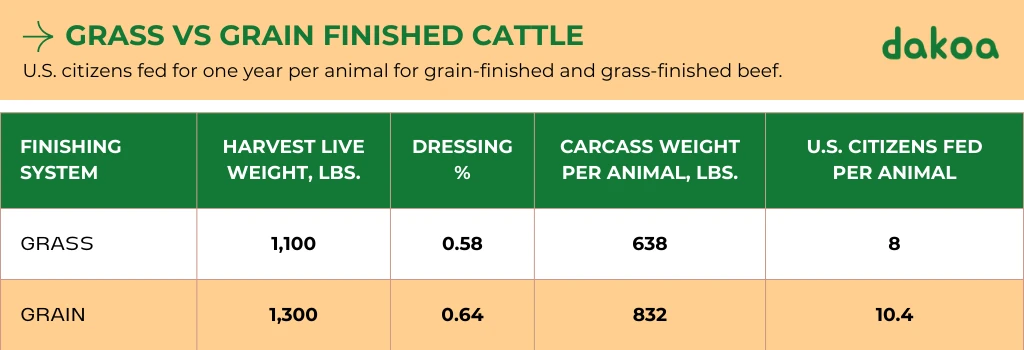In a recent study published on December 13th in the open-access journal PLOS ONE, Daniel Blaustein-Rejto and his team at the Breakthrough Institute in the United States unveiled some surprising findings about beef farming practices and their impact on carbon emissions. Contrary to conventional wisdom, it appears that beef operations committed to lifelong grass-based diets for their cattle may actually carry a heavier carbon footprint compared to those that transition their cattle to grain-based diets at a certain stage of their lives.

Traditionally, cattle raised on grass throughout their lives have been dubbed “pasture finished,” while those that switch to grain-based diets prior to slaughter are known as “grain finished.” Past research has hinted at the possibility that pasture-finished beef operations might contribute more to carbon emissions, but most studies have solely focused on the direct greenhouse gas emissions generated by beef production, failing to consider other critical factors influencing the overall carbon footprint.
To gain a more comprehensive perspective, Blaustein-Rejto and his team embarked on a groundbreaking analysis that evaluated and compared the carbon footprint of 100 beef operations located across 16 countries. Their calculations ventured beyond direct greenhouse gas emissions, delving into soil carbon sequestration – the process by which pasture soils capture and store atmospheric carbon, often through decomposing plants and cattle waste. The researchers accounted for the concept of carbon opportunity cost, which represents the carbon that could have been sequestered had the land been utilized for native ecosystems rather than beef production.
The results of their extensive statistical analysis revealed that pasture-finished operations indeed emitted 20% more greenhouse gases compared to grain-finished operations, aligning with previous studies. However, when incorporating the factors of soil carbon sequestration and carbon opportunity cost, the total carbon footprint of pasture-finished operations surged by an astonishing 42%. This increase in carbon emissions is largely attributed to the more intensive land use required for lifelong grass-based diets.

Further scrutiny of the data pointed to a robust correlation between the intensity of land use and the overall carbon footprint of beef operations. Remarkably, the calculations indicated that, on average across all the operations studied, carbon opportunity costs could potentially contribute even more to a given operation’s total carbon footprint than its direct greenhouse gas emissions.
In light of these findings, the researchers emphasize the critical importance of integrating carbon opportunity costs into climate mitigation efforts geared towards beef production. Since pasture-finished beef is often considered a premium product, this newly acquired carbon footprint data can also offer valuable insights to assist consumers in making informed choices about their meat consumption.
The authors of the study concluded, “Our research uncovers a stark reality – the carbon cost of land use represents the largest portion of beef’s carbon footprint. Therefore, the carbon burden of land-intensive beef operations, including many grass-fed systems, is even more substantial than typically recognized, even when we consider potential carbon sequestration resulting from grazing.” These findings underscore the complexity of sustainable beef production and the need for innovative approaches to reduce its environmental impact.

Moving Towards Sustainable Beef Production By Addressing the Carbon Challenge
With the revelation that lifelong grass-based beef farming may carry a higher carbon footprint than previously assumed, it’s time to consider real steps and strategies that can help mitigate the environmental impact of beef production. This new information presents both challenges and opportunities for the agricultural industry, policymakers, and consumers alike.
Sustainable Land Management
Encourage beef producers to adopt sustainable land management practices that promote carbon sequestration by emphasizing sustainable practices. This can involve techniques such as rotational grazing, reforestation, and planting cover crops, which can enhance soil health and carbon storage.
Farmers and ranchers can also optimize their land use efficiency to reduce carbon opportunity costs. This might include transitioning underutilized or marginal grazing lands into carbon-rich ecosystems, helping to offset emissions from beef production.
Now, before you roll your eyes and decide any changes to lower carbon emissions from your livestock aren’t worth making, consider the marketing angle!
Consumers are, for the first time in history, more prone to purchase food items, including meat, that have been marketed as sustainable. And over 30% of consumers are willing to pay a small premium to feel good (and, most likely, virtue signaling to their family and friends) about eating that steak at dinner.

Grain-finished beef is less expensive (less land cost and faster to market) and considerably lowers cattle-raising carbon emissions, meaning, your profit margin will likely be higher. It’s a win-win!
The most valuable thing a rancher can do at this point is almost common sense… provide balanced diets for cattle, with consideration for the different stages of their lives. Transitioning cattle to grain-based diets at specific points can help reduce emissions associated with extended pasture grazing. Cattle are grazers. They eat far more than grass and are happy to do so!
The government does have some half-way decent carbon pricing mechanisms that incentivize beef producers to reduce emissions and invest in carbon offset initiatives. They’re not as good as they should be (blame politics for that) but they’ll help.
The realization that pasture-finished beef may have a larger carbon footprint than previously recognized can’t, and shouldn’t, be ignored. We need a multifaceted approach to sustainable beef production if we want the industry to continue to thrive for the next many decades. After all, any business owner knows that change is expected and to be successful in the future, one must change with it.
More To Discover
- Lab-Grown Steaks From Israel Just Got The Greenlight
- Mark Zuckerberg Criticized for Luxury Cattle Ranch (Cows Enjoy Macadamia Nuts and Beer) in Hawaii, Raising Environmental and Social Concerns
- Palm Oil-Based Organic Solution Can Protect Cattle from Pests Without Insecticides
- Scientists Breed Climate-Friendly Cows with 20-Fold Increase in Milk Production
By implementing sustainable land management practices, promoting balanced diets for cattle, raising consumer awareness, enacting supportive policies, investing in research and innovation, and fostering collaboration, we can work collectively to reduce the carbon footprint of beef farming and create a more environmentally responsible meat industry. Ultimately, this approach will contribute to a healthier planet while still allowing consumers to enjoy high-quality beef products.
Source: Public Library of Science (PLoS)















